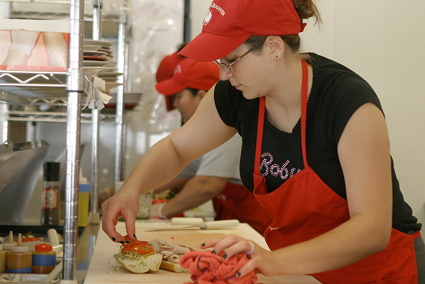
Local businesses, online sites make fundraisers relevant to
shoppers
School fundraisers no longer have to be a chore for parents and
teachers. Options for bringing in money have expanded beyond candy
bars, bake sales, wrapping paper and coupon book sales.
Local businesses and online sites are cropping up with donation
programs that allow people to give to their favorite school or
charity while making purchases.
Local businesses, online sites make fundraisers relevant to shoppers
School fundraisers no longer have to be a chore for parents and teachers. Options for bringing in money have expanded beyond candy bars, bake sales, wrapping paper and coupon book sales.
Local businesses and online sites are cropping up with donation programs that allow people to give to their favorite school or charity while making purchases.
The owners of The Running Rooster in Hollister found a way to donate to the community while building up their clientele. The shop offers complete take-home meals for busy folks as well as lunchtime meals such as hot sandwiches.
Brenda Black, who owns the business with her husband, Jim Chapman, approached local schools about partnering on fundraiser nearly two years ago.
“The key part as a startup is that we have tons of costs,” Black said. “But we have kids in school and we see the dire needs they have.”
Black and her staff worked with Hollister schools to assign fundraiser weeks throughout the year. This week, proceeds go to Ladd Lane and next week Cerra Vista will benefit. Visitors can ask that 10 percent of their purchase go to the specific school or charity that has been selected for a given week.
They sometimes support other nonprofits such as the Juvenile Diabetes Foundation. The store partnered with Hazel Hawkins Hospital for a six-day fundraiser at the beginning of September. They even altered the menu to appeal to kids and offered healthier choices. They added items such as “fruit” faces, lentil soup and salmon.
Since they launched their fundraising campaign in December 2005, the company has given at least $2,000 back. Fundraisers generally run only during the school year. They even provide fliers to the schools to send home with children. They advertise the fundraisers on their monthly menu and through an online newsletter.
“We give back a little, even if it is just a drop in the bucket,” Black said. “You’ve got to be creative nowadays and find fundraisers people can do. No one wants to hit their neighbors up [for fundraisers] every month.”
“Box Tops 4 Education” is another program that raises money for local schools through items people often purchase regularly. Raising money is as simple as clipping off the box top logo from items such as General Mill cereals, Betty Crocker baked goods and Ziploc storage containers. Schools redeem the box tops for money. Each box top is worth 10 cents.
Nonprofit organizations are also finding alternative ways to raise money.
The American Red Cross, Monterey and San Benito Counties chapter, recently hit on a program that allows online shoppers to donate up to 10 percent of their purchase straight to the nonprofit.
With www.shop.com, shoppers can search by item or by store for everything from baby supplies to electronics to magazines. As long as shoppers enter “Monterey ARC” when purchasing, the site collects the money for the local ARC chapter and sends a check every time $100 has been collected.
“It’s a win-win because you get to go shopping for one thing and give to a worthy cause,” said Laura Kershner, a spokesperson for the Monterey/San Benito counties chapter of the American Red Cross. “It makes it easy for those shopping online anyway to help out a worthy nonprofit.”
Shop.com has a hundreds of online vendors to choose from, ranging from online only vendors to well-known stores or brands like Circuit City or Black and Decker.
“So many people are on the Web now anyway and buying things, this is an easy way to make a contribution and sustain a charity that has been around for 108 years,” Kershner said.
Schoolpop.com is a similar Web site that is making a difference at local schools. At the site, visitors can choose which schools to support and can split donations between schools. Donations vary depending on the vendor, but up to 18 percent of purchases go to schools or nonprofits. Wal-Mart donates 6 percent while L.L. Bean donates 1 percent.
Like shop.com, the site offers a variety of merchandise and features well known companies such as Apple, Barnes and Noble and Best Buy.
Sacred Heart School started encouraging parents and teachers to shop at schoolpop.com when a vice principal stumbled upon the program.
“For schoolpop, they just need to enroll and it is strictly online,” said Diane Gibbs, the school bookkeeper.
eScrip is another program that the private school Sacred Heart has taken advantage of that allows people to register certain credit cards so that a percentage of purchases in specific stores go straight to their charity or school.
“Especially with the groceries, that is key. Everyone has to eat,” Gibbs said.
Safeway, for instance, donates up to 4 percent of purchases through the eScrip program depending on how much is spent each month.
“We’ve been able to generate more than $20,000 a year,” Gibbs said. “Its used for various needs for our operating budget. It has been used for extra painting or items that need to be replaced in the classroom.”









